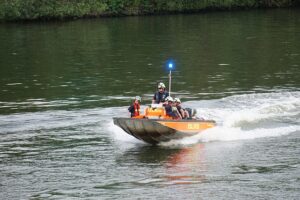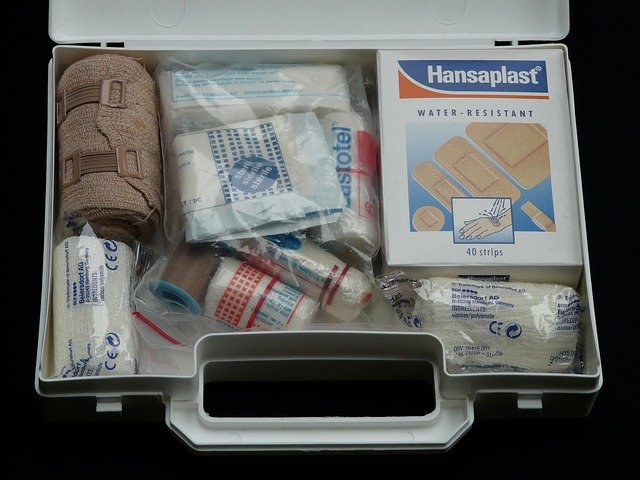 Injuries and accidents are a part of everyday life. The same is true for boating enthusiasts. Only this time, boating itself presents a rather different world of handling injuries. The US Coast Guard estimates that around 4,500 accidents and 3,000 injuries happen on the water every year. So if you want to get a taste of that boat life, you have to prepare.
Injuries and accidents are a part of everyday life. The same is true for boating enthusiasts. Only this time, boating itself presents a rather different world of handling injuries. The US Coast Guard estimates that around 4,500 accidents and 3,000 injuries happen on the water every year. So if you want to get a taste of that boat life, you have to prepare.
Building a boat first aid kit is your topmost priority. “But how do I build a boat first aid kit” you ask? Well, you’ve come to the right place. Here is a comprehensive guide to building one.
Basic Types of Injuries on a Boat
Before stocking up your boat safety kit, you might need to know what kinds of injuries may occur while you’re out on the water. Here’s what you should know.
- Soft tissue injuries: These are the usual ones like cuts, burns, and bruises, among others. Anybody can suffer a typical wound while on board a boat. Your biggest enemy with soft-tissue injuries is bleeding, and you need to stop it as early as possible.
- Musculoskeletal injuries: A common musculoskeletal injury is a broken bone. That means you have to have something that can stabilize a broken or dislocated bone joint. In a boat, this type of injury can be prevalent because of constant slip hazards.
- Cardiovascular and other deep-tissue ailments: It’s not always cuts or bruises. Sometimes, there might be things like heart ailments or any other emergencies. Most of the time, what happens to unaccustomed passengers is seasickness. It’s nothing serious, but one that your boat first aid kit must be prepared for all the same.
Related: Safety First: Boat Handling Tips During Bad Weather
Boating Emergency Kit Essentials

Now that you know what kinds of events you have to be ready for, here’s what you should get for your kit.
- Waterproof container: Let’s start with the most obvious. It doesn’t matter where you plan to put it. In a storage compartment in the cabin, or out in the deck. You’re on a boat, and as such would be at the mercy of the water. Your first aid kit’s contents should never, ever get wet before you get to use them. There are a lot of waterproof containers you can buy at affordable prices, so you won’t have to look far.
- *Scissors: Never build a first aid kit without scissors. This is practically a number one rule. You will always need something to cut gauze, bandages, and everything else. And out on sea, you must be prepared at all times. Ever try ripping a conventional gauze with only your hands? It’s not easy.
*Note: If you can, try to find curved scissors. They are specifically intended for medical purposes. These scissors have no sharp points. If you’re cutting something under stress (i.e. clothes off a patient), it can help avoid causing further injury. - Antiseptic/disinfectant: You must clean any wound and prepare it for dressing. A good amount of antiseptic/disinfectant will kiss infection bye-bye.
- Over-the-counter medication: Something might start hurting while you’re out on the water. It can be the chest, back, or anything else that might suffer from pain. That means it’s always handy to have a good amount of over-the-counter medication on board. Aspirin is good for unexplained chest pain, for instance. If you suspect a heart attack, have enough aspirin on board. There’s also ibuprofen (i.e. Advil) for musculoskeletal pain or inflammation. Lastly, something like Tylenol (acetaminophen) is good for pain that traditional painkillers can’t manage. You can also use this if there’s a high chance of bleeding, like after a massive injury.
- Gauze/bandages: This is pretty self-explanatory. Any injury with exposed flesh should always be covered. If for some reason you can’t find enough medical supplies, you must at least have bandages.
- Cotton swabs: You will always need something clean to apply antiseptic/disinfectant to any wound. Cotton swabs are perfect.
- Splints: You can buy premade splints for managing broken bones and the like. Or you can save a bit more money and gather any materials stable enough to act as such. For instance, you can use pieces of wood or metal to make a splint. Anything solid will do, really.
- Communication devices: You have two options: a mobile phone or a marine band radio. If you’re going to where you’re sure there’s adequate mobile signal, get a phone. Otherwise, go for a marine band radio. Remember that some injuries might be too serious for first-aid treatments to handle. You will need to get the patient to a better-equipped medical facility. A phone or radio will help you contact nearby authorities for an emergency evacuation.
Related: Survival Kit Essentials To Keep In Your Boat
Boating is already a great pastime by itself. But do you know what will make it even better? A feeling of safety and security. If you get injured, you don’t have to worry about something bad happening to you. And that’s what a boat first aid kit will always give you: absolute peace of mind.
